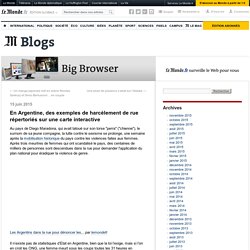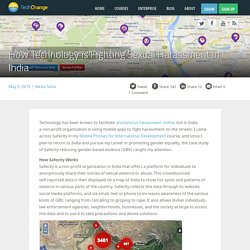

Hablame Bien (@HablameBienBA) En Argentine, des exemples de harcèlement de rue répertoriés sur une carte interactive. Au pays de Diego Maradona, qui avait tatoué sur son torse "perra" ("chienne"), le surnom de sa jeune compagne, la lutte contre le sexisme se prolonge, une semaine après la mobilisation historique du pays contre les violences faites aux femmes.

Après trois meurtres de femmes qui ont scandalisé le pays, des centaines de milliers de personnes sont descendues dans la rue pour demander l'application du plan national pour éradiquer la violence de genre. Les Argentins dans la rue pour dénoncer les... par lemondefr Il n’existe pas de statistiques d’Etat en Argentine, bien que la loi l’exige, mais si l’on en croit les ONG, une femme meurt sous les coups toutes les 31 heures en Argentine.
Tuées parce qu’elles sont tombées enceintes, poignardées par jalousie, assassinées après un divorce, selon La Casa del encuentro ("La Maison de la rencontre"), l’ONG porte-drapeau de la mobilisation, elles étaient 277 en 2014. Entre 2010 et 2012, 53 femmes sont mortes brûlées vives. Creating an environment that does not tolerate sexual harassment. How Technology is Fighting Sexual Harassment in India. Technology has been known to facilitate anonymous harassment online, but in India a non-profit organization is using mobile apps to fight harassment on the streets.

I came across Safecity in my Mobile Phones for International Development course, and since I plan to return to India and pursue my career in promoting gender equality, the case study of Safecity reducing gender-based violence (GBV) caught my attention. How Safecity Works Safecity is a non-profit organization in India that offers a platform for individuals to anonymously share their stories of sexual violence or abuse.
This crowdsourced self-reported data is then displayed on a map of India to show hot spots and patterns of violence in various parts of the country. Safecity collects this data through its website, social media platforms, and via email, text or phone to increases awareness of the various kinds of GBV, ranging from catcalling to groping to rape. Safecity reports Author Bio. Take Back The Tech! Map it. End it. Safetipin. To be the technology environment through which individuals, communities, researchers, NGOs, government and service providers, can access data, share information and act to make our cities safer.

Origins At SafetiPin, we believe that cities must be made safer and more inclusive for women and everyone. SafetiPin is a tool that works to enable cities to become safer through collection of data through crowdsourcing and other methods. The Safety Audit, that forms the core of SafetiPin, assesses different parameters linked to safer and more inclusive public spaces. We were fortunate to have an exceptional advisory board that provided us with comments, experience and ideas to make the Safety Audit rubric a strong and precise tool. The choice of the name - SafetiPin So why SafetiPin?
The second is that in India, traditionally women used the safety pin as a defence against street harassment, stalking harassment and bullying etc., especially in crowded places. Expansion of Safetipin 1. Safecity. Stop Violence Against Women & Children. Tfl Tumblr USB. Une carte pour orienterles femmes victimes de violences en île-de-france. In Rio de Janeiro's favelas, a new online tool tackles violence against women and girls - Office of the Secretary-General’s Envoy on Youth. UN-Habitat studies show that women in urban areas are twice as likely as men to suffer some form of violence, especially in developing countries.

Violence is a daily reality that disproportionately affects women and girls in the poorest districts of any city. Owing to their poverty, survivors among these populations have less access to support services, or they simply do not have the necessary information. In Brazil, sexual violence is a problem. Although reported cases reflect only a fraction of actual occurrences, data from the Rio de JaneiroState Secretariat for Public Security in 2012 show that compared to 2011, there was a sharp 23.8 per cent increase in cases of estupro (crimes which include rape and other violence) reported to the police in Rio de Janeiro.
In recent years, the Brazilian Government has invested heavily in mobile telephone networks and in broadband. “The objective is for the tool to be used by women and girls. SafeCities and the favelas Hope in Complexo do Alemão. New guidance mapping on mobile ict.